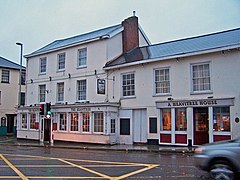
Livery Dole in Exeter, Devon, is an ancient triangular site between what is today Heavitree Road and Magdalen Road, in the eastern suburbs of Exeter. It was most notoriously used as a place for executions, and has contained an almshouse and chapel since 1591.

Exeter is a constituency composed of the cathedral city and county town of Devon represented in the House of Commons of the UK Parliament. The constituency has had a history of representatives from 1900 of Conservative, Liberal Party, Independent and Labour representation.
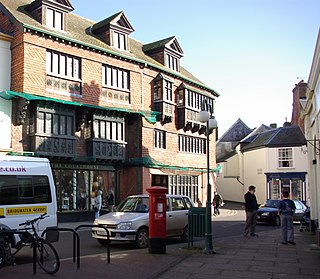
Wiveliscombe is a town and civil parish in Somerset, England, situated 9 miles (14 km) west of Taunton. The town has a population of 2,893. The Square, fronted by several listed structures, held the former market. The parish includes the nearby hamlet of Maundown.

Wonford is a former village, manor and ecclesiastical parish in Devon, England, now a part of the City of Exeter. The 13th century St Loye's Chapel situated within the parish now gives its name to the surrounding location. Wonford is situated next to the former parish of Heavitree, now both covered by the suburbs of Exeter.

The Royal Devon and Exeter Hospital, and with a main site sometimes known as Wonford Hospital, is a large teaching hospital situated in Exeter, Devon, England, and is run by the Royal Devon University Healthcare NHS Foundation Trust.
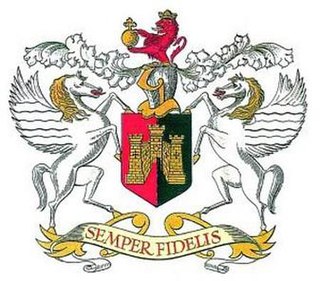
Exeter City Council is the local authority for Exeter, a non-metropolitan district with city status in Devon, England.

St James Priory, Exeter was a priory in Devon, England.

Thomas Benet from Cambridge, was an English Protestant martyr during the reign of King Henry VIII. In 1524, he moved to Torrington, North Devon, with his wife and family so that he could exercise his religious conscience more freely in a county where no one knew him. He was executed by burning on 15 January 1531, for heresy, at Livery Dole outside Exeter in Devon, under the supervision of Sir Thomas Dennis of Holcombe Burnell, near Exeter, then Sheriff of Devon.
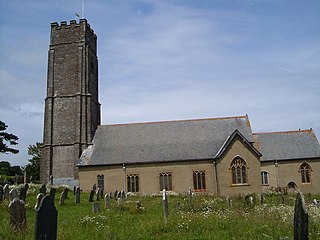
Stoke Fleming is a village and civil parish in the South Hams district of Devon, England. It lies on the A379 road about one and a half miles south of the town of Dartmouth, at the north end of Start Bay and within the South Devon Area of Outstanding Natural Beauty. In 2001 the parish had a population of 1,012, compared to 708 in 1901, reducing again to 803 at the 2011 census The parish is a major part of the Skerries electoral ward. The ward's total population at the same census was 1,927. Stoke Fleming has a pub called The Green Dragon, a primary school, library and a football club.

Tramways in Exeter were operated between 1882 and 1931. The first horse-drawn trams were operated by the Exeter Tramway Company but in 1904 the Exeter Corporation took over. They closed the old network and replaced it with a new one powered by electricity.

The Exeter Group is a Permian lithostratigraphic group which occurs through East Devon in southwest England. The name is derived from the city of Exeter in Devon which is partly underlain by rocks of this age.

Holcombe Burnell is a civil parish in the Teignbridge district, in Devon, England, the church of which is about 4 miles west of Exeter City centre. There is no village clustered around the church, rather the nearest village within the parish is Longdown. Only the manor house and two cottages are situated next to the church. The former manor house next to the church is today known as Holcombe Burnell Barton having subsequently been used as a farmhouse. The manor was in the historical Hundred of Wonford. In 2011 the parish had a population of 536.

Exeter is a cathedral city and the county town of Devon, South West England. It is situated on the River Exe, approximately 36 mi (58 km) northeast of Plymouth and 65 mi (105 km) southwest of Bristol.
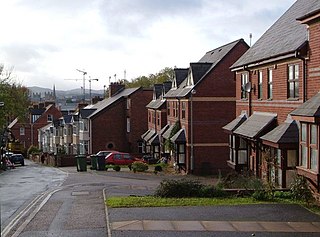
Polsloe is a suburb of the city of Exeter in Devon, England. It lies to the east of the city centre and is served by Polsloe Bridge railway station.

The 2021 Exeter City Council election took place on 6 May 2021 to elect the members of Exeter City Council in Devon, England. This was on the same day as other local elections. Two candidates were elected to the Mincinglake and Whipton ward due to a by-election taking place the same day following the death of a Councillor some months earlier.

The 2022 Exeter City Council election took place on 5 May 2022 to elect members to Exeter City Council in Devon, England. This was the same day as other local elections in the United Kingdom. 17 of the 39 seats were up for election, one councillor in each of the 13 wards, and 4 by-elections. These wards were last contested in 2018.
The Heavitree isolation hospital, also for a time known as the Exeter Corporation Tuberculosis Sanatorium, was a small pulmonary tuberculosis sanatorium located on Hollow Lane, Exeter, United Kingdom. The site is a few hundred metres to the west of the Whipton Hospital.
Whipton Barton was an estate farm to the East of Exeter. The 'Barton' suffix is the traditional Devon wording for the manor house, and indicates a demesne in the feudal system.
